标签:methods gets 参考 hold number 并且 ESS nts 包含
本文我们继续探究使用AQS的子类ReentrantReadWriteLock(读写锁)。老规矩,先贴一下类图
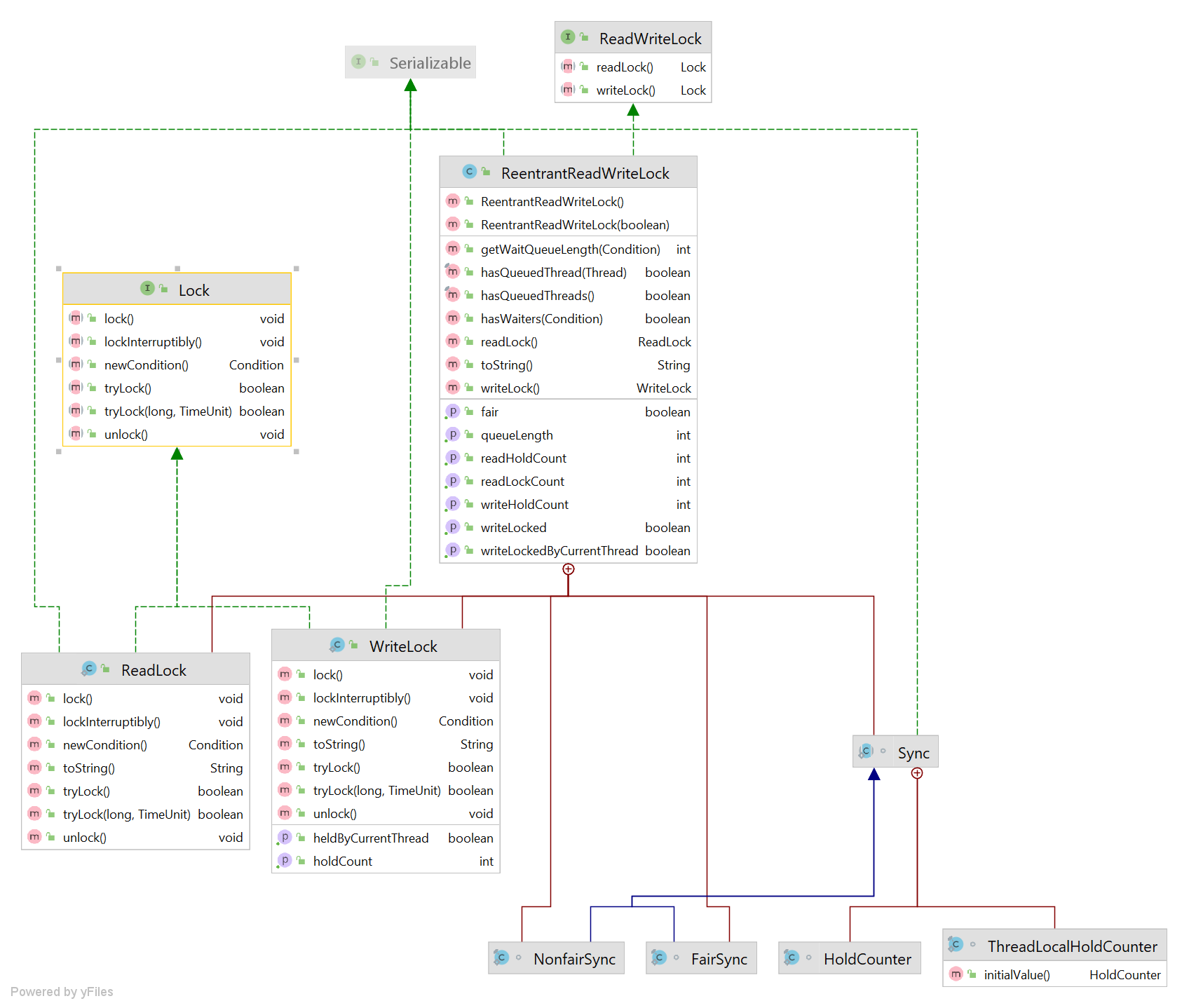
ReentrantReadWriteLock这个类包含读锁和写锁,这两种锁都存在是否公平的概念,这个后面会细讲。
此类跟ReentrantLock类似,有以下几种性质:
- 可选的公平性政策
- 重入,读锁和写锁同一个线程可以重复获取。写锁可以获取读锁,反之不能
- 锁的降级,重入还可以通过获取写锁,然后获取到读锁,通过释放写锁的方式,从而写锁降级为读锁。 然而,从读锁升级到写锁是不可能的。
- 获取读写锁期间,支持不可中断
先讲几个必要的知识点,然后我们再对写锁的获取与释放,读锁的获取与释放进行讲解,中间穿插着讲公平与非公平的实现。
知识点一:
内部类Sync中,将AQS中的state(private volatile int state;长度是32位)逻辑分成了两份,高16位代表读锁持有的count,低16位代表写锁持有的count
Sync
...
/*
* Read vs write count extraction constants and functions.
* Lock state is logically divided into two unsigned shorts:
* The lower one representing the exclusive (writer) lock hold count,
* and the upper the shared (reader) hold count.
*/
static final int SHARED_SHIFT = 16;
static final int SHARED_UNIT = (1 << SHARED_SHIFT);
static final int MAX_COUNT = (1 << SHARED_SHIFT) - 1;
static final int EXCLUSIVE_MASK = (1 << SHARED_SHIFT) - 1;
/** Returns the number of shared holds represented in count */
static int sharedCount(int c) { return c >>> SHARED_SHIFT; }
/** Returns the number of exclusive holds represented in count */
static int exclusiveCount(int c) { return c & EXCLUSIVE_MASK; }
...
This lock supports a maximum of 65535 recursive write locks and 65535 read locks. Attempts to exceed these limits result in Error throws from locking methods.(读锁与写锁都最大支持65535个)
知识点二:
HoldCounter的作用,一个计数器记录每个线程持有的读锁count。使用ThreadLocal维护。缓存在cachedHoldCounter
static final class HoldCounter {
int count = 0;
// Use id, not reference, to avoid garbage retention
final long tid = getThreadId(Thread.currentThread());
}
使用ThreadLocal维护 ??
static final class ThreadLocalHoldCounter
extends ThreadLocal<HoldCounter> {
public HoldCounter initialValue() {
return new HoldCounter();
}
}
维护最后一个使用HoldCounter的线程。简言之就是,假如A线程持有读锁,A线程重入获取读锁,在它之后没有其他线程获取读锁,那么当获取HoldCounter时,可以直接将cachedHoldCounter赋值给该线程,就不用从ThreadLocal中去查询了(ThreadLocal内部维持一个 Map ,想获取当前线程的值就需要去遍历查询),这样做可以节约时间。
private transient HoldCounter cachedHoldCounter;
当前线程持有的重入读锁count,当某个线程持有的count降至0,将被删除。
private transient ThreadLocalHoldCounter readHolds;
初始化在构造函数或readObject中
Sync() {
readHolds = new ThreadLocalHoldCounter();
setState(getState()); // ensures visibility of readHolds
}
private void readObject(java.io.ObjectInputStream s)
throws java.io.IOException, ClassNotFoundException {
s.defaultReadObject();
readHolds = new ThreadLocalHoldCounter();
setState(0); // reset to unlocked state
}
知识点三:
是否互斥 :
| 读操作 | 写操作 | |
|---|---|---|
| 读操作 | 否 | 是 |
| 写操作 | 是 | 是 |
只有读读不互斥,其余都互斥
获取到了写锁,也有资格获取读锁,反之不行.
知识点四
ReentranReadWriteLock,实现了ReadWriteLock接口。
public interface ReadWriteLock {
/**
* Returns the lock used for reading.
*
* @return the lock used for reading
*/
Lock readLock();
/**
* Returns the lock used for writing.
*
* @return the lock used for writing
*/
Lock writeLock();
}
ReadWriteLock维护着写锁和读锁。写锁是排他的,而读锁可以同时由多个线程持有。与互斥锁相比,读写锁的粒度更细
有了上面的知识,等会理解下面的源码就更容易了,故事从下面几个变量开始~
private final ReentrantReadWriteLock rwl = new ReentrantReadWriteLock();
private final Lock readLock = rwl.readLock();
private final Lock writeLock = rwl.writeLock();
ReentrantReadWriteLock的构造器,默认是非公平模式
/**
* Creates a new {@code ReentrantReadWriteLock} with
* default (nonfair) ordering properties.
*/
public ReentrantReadWriteLock() {
this(false);
}
/**
* Creates a new {@code ReentrantReadWriteLock} with
* the given fairness policy.
*
* @param fair {@code true} if this lock should use a fair ordering policy
*/
public ReentrantReadWriteLock(boolean fair) {
sync = fair ? new FairSync() : new NonfairSync();
readerLock = new ReadLock(this);
writerLock = new WriteLock(this);
}
写锁,排他锁;一个线程获取了写锁,其他线程只能等待
writeLock.lock();
java.util.concurrent.locks.ReentrantReadWriteLock.WriteLock#lock
public void lock() {
sync.acquire(1);
}
又来到了AQS的acquire方法
public final void acquire(int arg) {
if (!tryAcquire(arg) &&
acquireQueued(addWaiter(Node.EXCLUSIVE), arg))
selfInterrupt();
}
我们看ReentrantReadWriteLock是如何实现tryAcquire的
protected final boolean tryAcquire(int acquires) {
/*
* 对下面的条件做一个总述:
* 1. 当读锁或者写锁的count不为零时,同时拥有者不是当前线程,返回false
* 2. 当count达到饱和(超过最大的限制65535),返回false
* 3. 如果上面的情况都不是,该线程有资格去获取锁,如果它是可重入获取锁或队列策略允许它。那么就更新state并且设置锁的拥有者
*/
// 结合总述看下面的代码,很容易就看懂了
Thread current = Thread.currentThread();
int c = getState();
int w = exclusiveCount(c);
// 存在读锁或写锁
if (c != 0) {
// 情况分析: 1. w = 0, 表示已经获取了读锁(不管是自己还是其他线程),直接返回false
// 2. 写锁不为零,且当前锁的拥有者不是当前线程,返回false
if (w == 0 || current != getExclusiveOwnerThread())
return false;
if (w + exclusiveCount(acquires) > MAX_COUNT)
throw new Error("Maximum lock count exceeded");
// Reentrant acquire
setState(c + acquires);
return true;
}
// 不存在读锁或写锁被占用的情况
if (writerShouldBlock() ||
!compareAndSetState(c, c + acquires))
return false;
setExclusiveOwnerThread(current);
return true;
}
上面代码中的writerShouldBlock方法就是tryAcquire控制公平与否的关键,我们分别看看公平与非公平是如何实现的
默认情况下是非公平的
static final class NonfairSync extends Sync {
...
// 直接返回false
final boolean writerShouldBlock() {
return false;
}
...
static final class FairSync extends Sync {
...
final boolean writerShouldBlock() {
return hasQueuedPredecessors();
}
...
判断是否该线程前面还有其他线程的结点,上一节有讲到过。
这里还贴一下,整个acquire的流程图
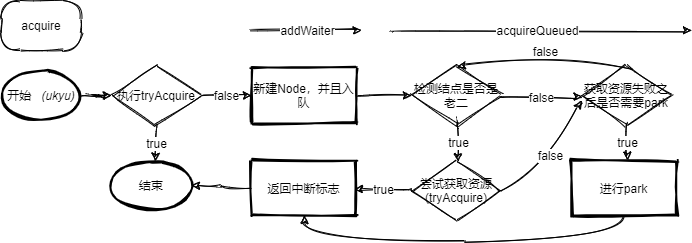
下面的这段代码,记得一定放在finally中
writeLock.unlock();
public void unlock() {
sync.release(1);
}
public final boolean release(int arg) {
if (tryRelease(arg)) {
Node h = head;
if (h != null && h.waitStatus != 0)
unparkSuccessor(h);
return true;
}
return false;
}
又看到了熟悉的面孔,但我们主要看的还是tryRelease, ??
protected final boolean tryRelease(int releases) {
if (!isHeldExclusively())
throw new IllegalMonitorStateException();
int nextc = getState() - releases;
boolean free = exclusiveCount(nextc) == 0;
if (free)
setExclusiveOwnerThread(null);
setState(nextc);
return free;
}
很简单,就贴一下release的流程图
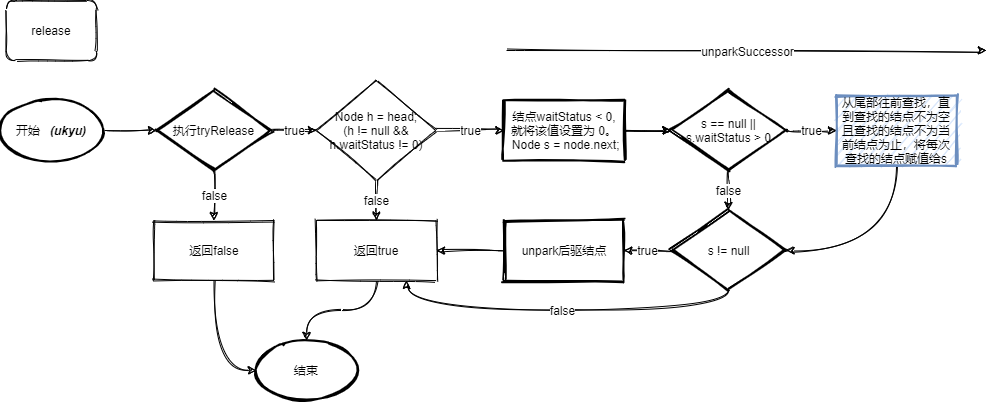
读锁与读锁并不互斥,可以存在多个持有读锁的线程??
readLock.lock();
public void lock() {
sync.acquireShared(1);
}
public final void acquireShared(int arg) {
if (tryAcquireShared(arg) < 0)
doAcquireShared(arg);
}
之前的文章还没有讲解过tryAcquireShared在子类如何实现的。看看如何实现的 ??
protected final int tryAcquireShared(int unused) {
/*
* 对下面的条件做一个总述:
* 1. 如果写锁被其他线程持有,失败
* 2. 否则,如果此线程有资格去获取写锁,首先查询是否需要阻塞(readerShouldBlock).如果不需要,就通过CAS更新state。
*
* 3. 如果上面两步都失败了,可能是当前线程没有资格(需要被阻塞),或CAS失败,或者count数量饱和了,然后执行fullTryAcquireShared进行重试
*/
Thread current = Thread.currentThread();
int c = getState();
// 这里可以看出,若该线程持有写锁,同样也可以去获取读锁
if (exclusiveCount(c) != 0 &&
getExclusiveOwnerThread() != current)
return -1;
int r = sharedCount(c);
// readerShouldBlock表示此线程是否被阻塞(后面细谈)
// 多个线程执行compareAndSetState(c, c + SHARED_UNIT), 只有一个线程可以执行成功,其余线程去执行fullTryAcquireShared
if (!readerShouldBlock() &&
r < MAX_COUNT &&
compareAndSetState(c, c + SHARED_UNIT)) {
if (r == 0) {
// firstReader是第一个获取到读锁的线程
// firstReaderHoldCount是firstReader持有的count
firstReader = current;
firstReaderHoldCount = 1;
} else if (firstReader == current) {
// 重入
firstReaderHoldCount++;
} else {
// sync queue还存在其他线程持有读锁,且该线程不是第一个持有读锁的线程
// 结合上面的知识点二,理解下面的逻辑
HoldCounter rh = cachedHoldCounter;
if (rh == null || rh.tid != getThreadId(current))
cachedHoldCounter = rh = readHolds.get();
else if (rh.count == 0)
readHolds.set(rh);
rh.count++;
}
return 1;
}
// 到达这里的线程,1. 没有资格获取(需要阻塞) 2. CAS失败 3. 读锁count饱和
return fullTryAcquireShared(current);
}
Full version of acquire for reads, that handles CAS misses and reentrant reads not dealt with in tryAcquireShared.
final int fullTryAcquireShared(Thread current) {
// 主要逻辑跟上面的tryAcquireShared类似。tryAcquireShared的逻辑只有一个线程会成功CAS,
// 其余的线程都进入fullTryAcquireShared,进行重试(代码不那么复杂)
HoldCounter rh = null;
for (;;) {
int c = getState();
if (exclusiveCount(c) != 0) {
if (getExclusiveOwnerThread() != current)
return -1;
// else we hold the exclusive lock; blocking here
// would cause deadlock.
} else if (readerShouldBlock()) { // 需要被阻塞
// Make sure we‘re not acquiring read lock reentrantly
if (firstReader == current) {
// assert firstReaderHoldCount > 0;
} else {
// 此时, 如果该线程前面已经有线程获取了读锁,且当前线程持有的读锁count为0,从readHolds除去。
if (rh == null) {
rh = cachedHoldCounter;
if (rh == null || rh.tid != getThreadId(current)) {
rh = readHolds.get();
if (rh.count == 0)
readHolds.remove();
}
}
// 这里表示该线程还是一个new reader, 还没有持有读锁
if (rh.count == 0)
return -1;
}
}
if (sharedCount(c) == MAX_COUNT)
throw new Error("Maximum lock count exceeded");
// 这里只有一个线程会成功,若CAS失败,一直重试直到成功,或者读锁count饱和,或者需要被阻塞为止
if (compareAndSetState(c, c + SHARED_UNIT)) {
if (sharedCount(c) == 0) {
firstReader = current;
firstReaderHoldCount = 1;
} else if (firstReader == current) {
firstReaderHoldCount++;
} else {
if (rh == null)
rh = cachedHoldCounter;
if (rh == null || rh.tid != getThreadId(current))
rh = readHolds.get();
else if (rh.count == 0)
readHolds.set(rh);
rh.count++;
cachedHoldCounter = rh; // cache for release
}
return 1;
}
}
}
我们上面看到了readerShouldBlock,这个方法是控制读锁获取公平与否,下面我们分别看看在非公平与公平模式下的实现 ??
static final class NonfairSync extends Sync {
...
final boolean readerShouldBlock() {
/* As a heuristic to avoid indefinite writer starvation,
* block if the thread that momentarily appears to be head
* of queue, if one exists, is a waiting writer. This is
* only a probabilistic effect since a new reader will not
* block if there is a waiting writer behind other enabled
* readers that have not yet drained from the queue.
*/
return apparentlyFirstQueuedIsExclusive();
}
...
}
判断sync queue的head的后继结点是否是写锁(独占模式)
final boolean apparentlyFirstQueuedIsExclusive() {
Node h, s;
return (h = head) != null &&
(s = h.next) != null &&
!s.isShared() &&
s.thread != null;
}
上面的方法是,获取读锁时,避免导致写锁饥饿(indefinite writer starvation)的一个措施,下面我们对它进行详细的解释
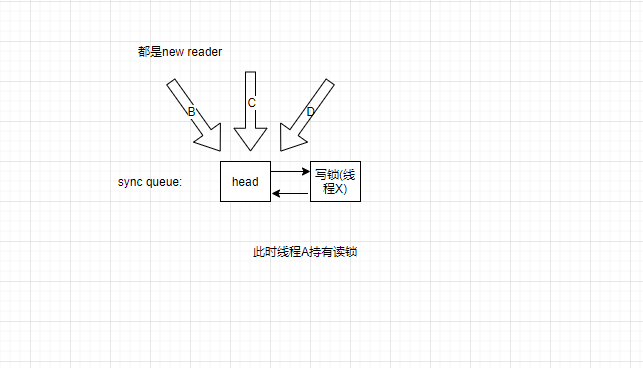
结合上面的图片,我们设想有一个这样的情况,写锁没有被获取,线程A获取到了读锁,此时另一个线程X想要获取写锁,但是写锁与读锁互斥,所以此时将线程X代表的node添加到sync queue中,等待读锁被释放,才有资格去获取写锁。
上面的情况 + 不存在判断sync queue的head的后继结点是否是写锁(apparentlyFirstQueuedIsExclusive)的方法时,我们看看会出什么问题
时刻一: 线程B、线程C,线程D是新建线程想要去获取读锁(new reader),此时因为不存在写锁被获取,所以线程B、线程C,线程D都会在fullTryAcquireShared中不断重试,最终都获得读锁
时刻二: 线程A释放,会执行unparkSuccessor,此时线程X被唤醒,但是执行到tryAcquire,又检测到读锁被持有(不管是自己还是是其他线程),线程X又被阻塞。线程B释放,还是会出现这种情况,只有等到最后一个读锁被释放,线程X才能获取到写锁。但是想想如果后面一连串的读锁,线程X不是早就被‘饿死了‘
apparentlyFirstQueuedIsExclusive,就可以防止这种‘写锁饥饿‘的情况发生。线程B、线程C,线程D只有被阻塞,等待线程X获取到写锁,才有机会获取读锁。
/**
* Fair version of Sync
*/
static final class FairSync extends Sync {
...
final boolean readerShouldBlock() {
return hasQueuedPredecessors();
}
...
}
这里关于读锁的获取(公平与非公平)分析完了,贴一张整个acquireShared的流程图
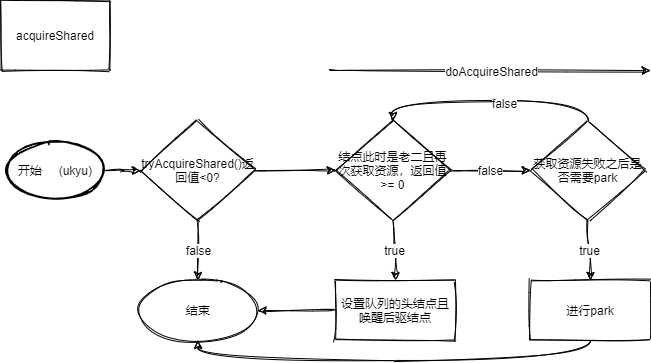
readLock.unlock();
public void unlock() {
sync.releaseShared(1);
}
AQS
public final boolean releaseShared(int arg) {
if (tryReleaseShared(arg)) {
// 唤醒head后驱结点
doReleaseShared();
return true;
}
return false;
}
// unused = 1
protected final boolean tryReleaseShared(int unused) {
Thread current = Thread.currentThread();
if (firstReader == current) {
// assert firstReaderHoldCount > 0;
if (firstReaderHoldCount == 1)
firstReader = null;
else
firstReaderHoldCount--;
} else {
HoldCounter rh = cachedHoldCounter;
if (rh == null || rh.tid != getThreadId(current))
rh = readHolds.get();
int count = rh.count;
if (count <= 1) {
readHolds.remove();
if (count <= 0)
throw unmatchedUnlockException();
}
--rh.count;
}
for (;;) {
int c = getState();
// 获取读锁时,会执行 compareAndSetState(c, c + SHARED_UNIT),这里就是减SHARED_UNIT
int nextc = c - SHARED_UNIT;
if (compareAndSetState(c, nextc))
// 释放读锁,对需要读锁的线程没有影响(读读不互斥)
// 但是,这里如果返回true,可以唤醒被阻塞的想要持有写锁的线程
return nextc == 0;
}
}
使用读写锁的情况,应该取决于与修改相比,读取数据的频率,读取和写入操作持续的时间。
例如:
JAVA并发(3)-ReentrantReadWriteLock的探索
标签:methods gets 参考 hold number 并且 ESS nts 包含
原文地址:https://www.cnblogs.com/ukyu/p/14809925.html